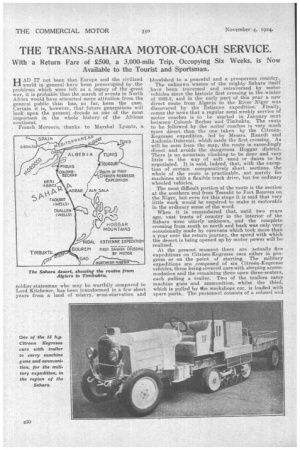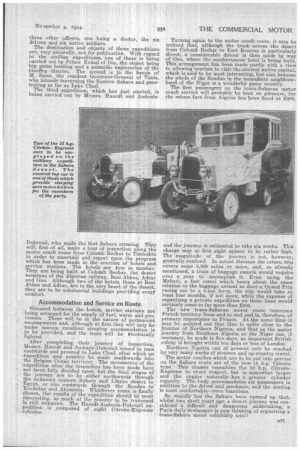THE TRANS-SAHARA MOTOR-COACH SERVICE.
Page 14

Page 15

If you've noticed an error in this article please click here to report it so we can fix it.
With a Return Fare of 000, a 3,000-mile Trip, Occupying Six Weeks, is Now Available to the Tourist and Sportsman.
HAD IT not been that Europe and the civilized world in general have been preoccupied by the problems which were left as a legacy of the great war, it is probable that the march of events in North Africa would have attracted more attention from the general public than has so far, been the case. Certain it is, however, that future generations will look upon the present decade as one of the most important in the whole history of the African continent.
French Morocco, thanks to Marshal Lyantz, a. bloodshed to a peaceful and a prosperous country.
The unknown wastes of the mighty Sahara itself have been traversed and retraversed by motor 'vehicles since the historic first crossing in the winter of 1922-3, and in the early part of this year a new direct route from Algeria to the River Niger was discovered by the Estienne expedition. Finally, comes the news that a regular semi-weekly service of motor coaches is to be started in January next between Colomb Bechar and Timbuktu. The route to be followed by the motor coaches is very much more direct than the one taken by the itroenKegresse expedition, led by Messrs. Haardt and Audouin-Dubreuil, which made the first crossing. As will be seen from the map, the route is exceedingly direct and avoids the dangerous Hoggar district. There is no mountain climbing to be done and very little in the way of soft sand or dunes to be negotiated. It is said, indeed, that, with the exception of certain comparatively short sections, the whole of the route is practicable, not merely for machines with a flexible track drive, but for ordinary wheeled vehicles.
The most difficult portion of the route is the section at the southern end from Tessalit to Fort Bourein on the Niger, but even for this stage it is said that very little work would be required to make it motorable in the ordinary sense of the word.
When it is remembered that, until two years ago, vast tracts of country in the interior of the Sahara were utterly unknown, and the complete crossing from south to north and back was only very occasionally made by caravans which took more than a year over the return journey, the speed with which the desert is being opened up by motor power will be realized.
At the present moment there are actually five expeditions on Citroen-Kegresse cars either in progress or on the point of starting. The military expeditions are composed of six Citroen-Kegresse vehicles, three being covered cars with sleeping accommodation and the remaining three open three-seaters, each pulling a trailer. Two of the trailers carry machine guns and ammunition, whilst the third, which is pulled by &he workshops car, is loaded with spare parts. The personnel consists of a colonel and
three other officers, one being a doctor, the six drivers apd six native soldiers.
The destination and objects of these expeditions are, very naturally, not for publication. With regard to the civilian expeditions, one of these is being carried out by Prince Kemal el Din, the object being big game hunting and a scientific exploration of the Gouffra district. The second is in the hands of NI. Saint, the resident Governor-General of Tunis, who intends traversing the Eastern Sahara and penetrating as far as Lake Chad.
The third expedition, which has just started, is being carried out by Messrs. Haardt and Audouin Dubreuil, who made the first Sahara crossing. They will, first of all, make a tour of inspection along the motor coach route from Colomb Bechar to Timbuktu in order to ascertain and report upon the progress which has been made in the erection of hotels and service stations. The hotels are four in number. They are being built at Colomb Bechar, the desert terminus of the Algerian railway, Beni Alabes, Adrar and Gao. Although two of the hotels, those at Beni Abbes and Adrar, are in the very heart of the desert, they are to be substantial buildings providing every comfort.
Accommodation and Service en Route.
Situated between the hotels, service stations are being arranged for the supply of fuel, water and provisions. These will be in the nature of permanent encampments and, although at first they will only be under canvas, excellent sleeping accommodation is to be provided, and the tents will be tleetrically lighted.
After completing their journey of inspection, Messrs. Haardt and Audouin-Dubreuil intend to turn eastwards and proceed to Lake Chad, after which an expedition may possibly be made southwards into the Belgian Congo territory. The movements of the expedition after the inspection has been made have not been fully decided upon, but the final stages of the journey are to be either northwards through the unknown eastern Sahara and Libyan desert to Egypt, or else eastwards through the Soudan to Kordofan and Abyssinia. Whichever route is nally chosen, the results of the expedition should be most interesting, as much of the country to be traversed is still unknown. The Haardt-Audouin-Dubreuil expedition is composed of eight Citroen-Segresse vehicles. Turning again to the motor coach route, it may be noticed that, although the track across the desert from Colomb Bechar to Fort Bourem is particularly direct, a considerable detour is then made by way of Gao, where the southernmost hotel is being built. This arrangement has been made partly with a view to allowing tourists to visit the ancient native capital, which is said to be most interesting, but also because the whole of the Soudan in the immediate neighbourhood of the Niger is a wonderful game country. The first passengers on the trans-Saharan motor coach service will probably be bent on pleasure, for the return fare from Algeria has been fixed at 2500,
and the journey is estimated to take six weeks. This charge may at first sight appear to be rather high. The magnitude of the journey is not, however, generally realized. In actual distance the return trip covers some 3,000 miles , or more, and, as already mentioned, a train of baggage camels would require over a year to accomplish it. Even using the Mehari, a. fast camel which bears about the same relation to the baggage animal as does a Grand Prix racing car to a 5-ton lorry, the trip would take at least four months, if not more, while the expense of organizing a private expedition on these lines would certainly come to far more than 2500. The new trans-Saharan motor route traverses French territory from end to end and is, therefore, of primary importance to France. At the same time it may be pointed out that Gao is quite close to the frontier of Northern Nigeria, and that as the motor journey from Southern Algeria to the Niger can, if necessary, be made in five days, an important British colony is brought within ten days or less of London.
Northern Nigeria can at present only be reached by very many weeks of steamer and up-country travel. The motor coaches which are to be put into service on the Sahara route are of the new i h.p. Citroen type. This chassis resembles the 10 h.p. CitroenKegresse in every respect, but is somewhat larger and the engine naturally has a greater cylinder capacity. The body accommodates six passengers in addition to the ,driver and mechanic, and the seating is most comfortable—even luxurious.
So rapidly has the Sahara been opened up that, whilst, two short years ago a desert journey was considefasd a difficult and dangerous undertaking, a Paris daily neWspa.per ia now thinking of organizing a trans-Sahara motor reliability trial!
































